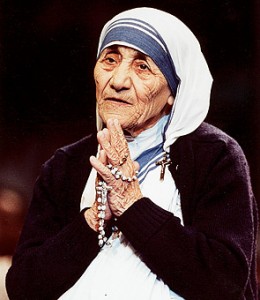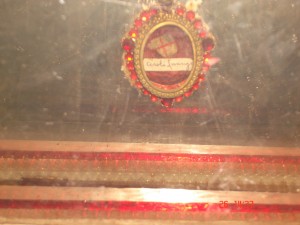Reflections on a Pauline Pilgrimage to Turkey [12]
Jesus said to Nicodemus: “God loved the world so much that he gave his only Son, so that everyone who believes in him may not be lost but may have eternal life” [John 3:16].
It is Wednesday 4 May 2011, the last but one day of our pilgrimage trip to Turkey. We will start the day with an early morning Mass at our hotel at Kusadasi. It is time to reflect on the readings before we begin another long day.
The Gospel reading is taken from John 3:16-21. “God loved the world so much that he gave his only Son!” Just a few words of Holy Scripture, but they contain a fundamental truth of the Christian faith. That truth is at the root of the Incarnation of the Word, the coming to earth of Christ the Son. Clearly, two key words from the Gospel of the day are the pair of truth and light. About this pair, we propose three points for reflection and on-going dialogue.
[1] The Blessed Mother Teresa of Calcutta.[2] Andrei Rublev’s Trinity icon. [3] Relics of the Martyrs hanging from the Altar, Shrine of the Ugandan Martyrs.
[1] Truth and Life
“God loved the world so much that he gave his only Son!” – a few words of Scriptures so indelibly edged on our minds, not so much because of our hefty course on The Gospel According to John in Leuven, Belgium, but more on account of the memorable visit of the Blessed Mother Teresa of Calcutta in 1991 to that university city where we studied theology.
News of Mother Teresa’s visit reverberated across the campus and the city. With eager expectation, we went early to the Holy Spirit College where she was appointed to speak, and headed to the front row seats on the loft, ensuring a strategic position for the best view in the hall. The famous Nun was late, understandably, since so many would jostle for so little of her time. Delay only magnified the expectations. But when she finally walked in from the back of the stage, Mother Teresa looked so old, so small, slightly hunched and, well, so disappointing on a big stage. Suddenly, after all that heightened expectations, it all seemed like it was going to be a great disappointment after all. But, the moment she began to speak, we had an electric shock. In her stunning simplicity, she declared: “God so loved the world that he gave his only Son.” We were stunned. We were electrified. We did not hear anything else she said after that. We wanted to scream, “It is true! It is true!” In that magnificent hall of the Heilige Geestcollege, Leuven, we knew that the Incarnation of Christ was true because Mother Teresa who proclaimed the Gospel lived its truth in her life.
More than any theology professor possibly could, Mother Teresa convinced us of the truth of God’s love and of the sending of his Son. She was a living reminder on love. We would go on to learn in our theological formation that truth is not something to be insisted upon in argumentation. Truth is something lived. Truth is performed.
That day, however, she taught us more than any theology books that truth must be connected to life, that faith must be reflected in action, and that words must be matched by deeds. Or, as a fellow pilgrim on the footsteps of St Paul put it in her characteristically arresting precision: “All talk and ‘no do’ is not very good, really.”
[2] True Love is Concrete
“God loved the world so much that he gave his only Son!” In those few words, God is teaching us that “the love of God” is useless, unless we can touch it, feel it, and experience it. True love is concrete. Now we know why God came amongst us in his Son. The Incarnation is real; it is concrete. “In the beginning was the Word … The Word took flesh, and pitched tent amongst us,” St John the evangelist declared, “full of grace and truth; and we have beheld his glory, glory as of the only Son from the Father” [John 1:1, 14]. The Incarnation was not a pretension as the docetists claimed.
The Incarnation also teaches that true love involves pain. It costs. True love always involves making sacrifices. And Jesus the Son has shown that true love goes all the way, “to the end”.
[3] Truth and Light
To accept that “God loved the world so much he gave his only Son” is to understand also that the Triune God is missional. Then, we must go on to see that the Church does not exist for its own sake. Rather, mission is the raison d’etre of the Church. In baptism, we each were recreated, as it were, with missional DNA.
Life may deal us unwanted surprises and disappointments sometimes. But life is good; it is given by God. Life by nature is full of good times and bad times. The question that must always surface is whether we have a vision of what we want to be. We know that this vision is built on solid ground when our unyielding focus is truth, service and justice. Difficulties and bad times may visit upon us, but what we are not allowed to do is to abandon our vision! That is the singular light that guides Christians in spiritually difficult times, times of darkness.
Truth, then, is always in close association with light. The two verses in today’s gospel reading, verses 20 and 21 of John 3, are easily one of our favourite passages in the Bible.
- “For every one who does evil hates the light, and does not come into the light, lest his deeds should be exposed . But he who does what is true comes into the light, that it may be clearly seen that his deeds have been wrought in God.”
Again and again, this Scripture has given us strength and consolation and we have used it on several occasions to help others who sought our counsel.
- Have you ever felt defamed or unjustly treated?
- Have you been grossly misunderstood or misjudged?
- Have others been speaking ill of you behind your back?
Fret not. Walk tall in the light. God operates on the golden principle of the intrinsically-good. God is your judge. Have no fear because God is on the side of what is true and good.
In this Pauline pilgrimage, we can remind ourselves that even death cannot kill the truth, for the light will prevail. As we continue to read the Acts of the Apostles during the Easter season, the first reading today, Acts 5:17-26, talks about the jealousy of the high priest in the company of all his supporters from the party of the Sadducees. They arrested the apostles and put them in the common gaol. Two things happened: Angels came and released the apostles; and high-handed punishment through incarceration could never extinguish the spirit of the apostles to preach the truth.
St Paul, along with many other spiritual ancestors of ours, was martyred.
- They vehemently insisted on the truth.
- They lived and died for the truth.
- They would rather die for the faith than to deny Jesus.
The most famous Christian icon in the world, Rublev’s icon of the Holy Trinity, is spiritually heart-warming here. Would-be martyrs in particular and all who labour and enter into various forms and degrees of suffering for and on account of living out the faith in general, will find in this icon immense encouragement and consolation. The table of suffering – pointing to the altar of sacrifice – is bare, save for the cup of suffering. And we the viewers are given the generous invitation to take the empty seat reserved for each one of us. And as we approach it, we shall see that cut into the front panel of the table is a special sanctuary reserved for the relics of martyrs. God-the-Son is the Suffering Messiah. God understands suffering. God silently registers his appreciation for a life of faith and sacrifices. Martyrs, the artist is telling us, find a special place in the heart of the Triune God!
Echoing this same message, a specially-designed box containing the relics of the holy Ugandan Martyrs hangs from the altar at the Shrine of the Ugandan Martyrs, at Namugongo, Kampala, Uganda.
May the Lord be our constant help so we may always live by and persevere in the truth and walk in the light!
Copyright © Dr. Jeffrey & Angie Goh, January, 2012. All rights reserved.
You are most welcome to respond to this post. Email your comments to us at jeffangiegoh@gmail.com. You can also be dialogue partners in this Ephphatha Coffee-Corner Ministry by sending us questions for discussion.


